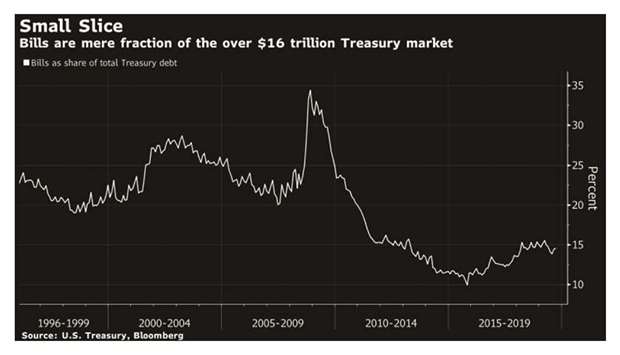Traders are signalling that the Fed may need to start buying more than just Treasury bills, moving further out the yield curve in order to assert greater control over its main policy rate.
Treasury bills – US government securities maturing in one year or less that don’t have coupon payments – are currently the focus of the Fed’s plan to buy $60bn a month of debt to facilitate the management of bank reserves. Yet there is speculation that real-money funds might prove reluctant to sell and the Fed will find it hard to fulfil that bill-purchase quota.
As a result, two-year notes – which could be next in line for Fed purchases – are outperforming longer-maturity Treasuries. While benchmark 30-year rates have climbed more than five basis points this week, and 10-year yields are up more than four, the two-year yield has remained relatively steady.
Strategists are already on the case, with several Wall Street banks recommending the Fed move beyond just bills.
The Fed’s aggressive buying of T-bills risks displacing money-market funds and sending them into other front-end assets, Bank of America strategists said in a research note this week, adding the central bank may need to consider targeting purchases of short-dated coupon-bearing securities.
At JPMorgan Chase & Co, Nikolaos Panigirtzoglou calls the Fed’s apparent reluctance to move further out along the curve an error in judgment as it will slow the needed addition of liquidity to the banking sector.
But the central bank may be reluctant to widen the list of securities included in the purchases. That’s in part because they have been at pains to stress that they are not engaging in full-blown quantitative easing that would include buying longer maturities.
Christoph Rieger, head of rates strategy at Commerzbank AG, points out that the Fed distinguishes between purchases made for “technical reasons” and those mandated by monetary policy. “Therefore moving further out the curve with their outright purchases is probably more contentious,” he says.
The first of the Fed’s bill-purchase operations held on Wednesday went smoothly enough, drawing offers to sell 4.34 times the $7.5bn of debt the central bank was looking to buy. The lack of any pricing data however made it difficult to gauge whether it had to pay above prevailing market levels to achieve its purchases.
There remains speculation that money-market funds and other real-money players could prove reluctant to let go of their holdings unless the Fed offers a substantial premium over current market levels.
The Fed’s bill purchases may have been expected to ease pressure on the other tool it is using to ease funding stress: its daily repurchase operations. The repo action on Wednesday however was fully subscribed for the first time this month, underscoring the risk that any sign of difficulties filling bill-purchase targets will exacerbate the overall funding stress.

.


